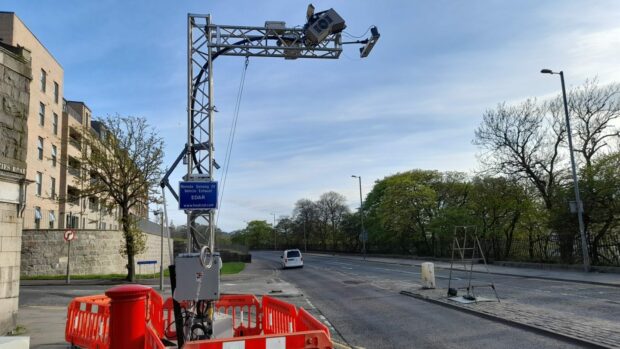A specialised camera that detects the emissions of individual vehicles has been installed on the most-polluted street in Aberdeen.
The Emission Detection and Reporting (EDAR) system has recently been erected on Wellington Road, at the junction with Grampian Place.
All vehicles that pass beneath the device are scanned, and the system is able to create an accurate measure of the potentially harmful emissions coming out of their exhausts.
The unmanned system, which was developed by the American company Hager Environmental and Atmospheric Technologies (HEAT), can operate “24 hours a day, seven days a week, 365 days a year”.
How does the Wellington Road camera work?
On the company’s website, which is printed on the device on Wellington Road, it explains the EDAR technology uses “eye-safe, laser-based technology”.
HEAT says the system being used in Aberdeen is capable of “remotely detecting and measuring the infrared absorption of environmentally critical gases coming out of a moving vehicle.”
— Hager Environmental & Atmospheric Technologies (@heatrsd) May 2, 2022
What this means is the device scans what comes out of each vehicle that goes past it, and creates a snapshot of pollutants like nitrogen dioxide and particulate matter that each vehicle emits.
According to the company, EDAR camera can “capture thousands of vehicles all while drivers are on their daily commute without any inconvenience to the motorists.
“The EDAR system can measure the actual environmental damage a vehicle is causing.
“This technology can be used to give governments the ability to accurately determine how much pollution any individual vehicle is causing, and take corrective actions to reduce those emissions.”
How bad is air pollution on Wellington Road?
Although it’s not as built up as Scotland’s larger cities of Glasgow and Edinburgh, the Granite City has its fair share of air pollution problems.
Official data analysed by the campaign group Friends of the Earth Scotland earlier this year found the dirtiest streets for nitrogen dioxide in the air in Aberdeen over 2021 were Wellington Road, Market Street and Union Street.
Wellington Road was named the worst for this particular kind of pollutant.
And across Scotland as a whole, Wellington Road held the unfortunate title of 11th worst street for nitrogen dioxide pollution.
Why is the camera being used in Aberdeen?
HEAT and two partner organisations have been awarded a contract by Transport Scotland to install a monitoring network to detect emissions on roads in Glasgow, Edinburgh, Dundee and Aberdeen using EDAR.
.@HeatRSD is in Scotland! 1st-time #RealWorldEmissions testing is underway in Aberdeen and Dundee. #VehicleEmissions #CleanAir pic.twitter.com/peuX42c3JI
— Hager Environmental & Atmospheric Technologies (@heatrsd) April 26, 2022
According to HEAT’s website, the network will “help reduce the amount of harmful pollutants in the air caused by vehicles”, and “the goal is to ultimately improve air quality and the health of Scottish citizens while creating a streamlined infrastructure to mitigate excess pollution and the misuse of emissions controls”.
A spokesman for Aberdeen City Council said “The equipment is being used to measure vehicle emissions in Aberdeen in a joint project between Aberdeen City Council and Transport Scotland.”
Transport Scotland did not comment.




Conversation